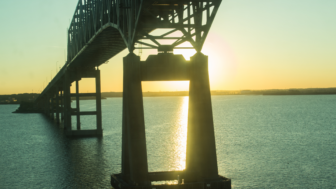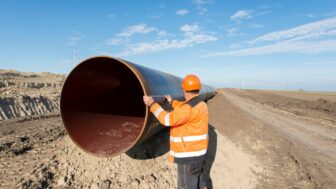One year after a train carrying acetone derailed in the Howard Street Tunnel, advocates called on the City Council to take steps to protect public health and safety from trains carrying explosive crude oil through the city.
BALTIMORE — Today, residents of Baltimore’s crude oil train blast zone, MICA staff and faculty, elected officials, and labor and environmental advocates rallied to commemorate the 1-year anniversary of a train derailment in the Howard Street Tunnel and discussed the public health and safety threats posed to Baltimoreans by dangerous crude oil trains.
During a rally in Frost Plaza on Tuesday June 13, speakers recalled last year’s dangerous 13-car derailment, which carried highly flammable substances including acetone and natural gas and took over 24 hours to clear. The speakers renewed demands from community members, local activists, and environmental organizations for the City Council to take steps to protect the public from trains carrying hazardous cargo such as crude oil through Baltimore.
Councilwoman Mary Pat Clarke, representative of Baltimore’s District 14, said: “Crude oil transport through Baltimore is a dangerous venture. At the least, our residents require State and local coordination to secure better notice of such transport, more secure carriers than now employed, and a concerted plan of prevention and response to potential accidents.”

Councilwoman Clarke speaks to the crowd.
Valeska Populoh, a faculty member at MICA, reflected on last year’s derailment: “The incident has raised my concerns about the transport of hazardous materials on these rail lines so close to our campus and the surrounding community, the potential threats to health and safety that these pose, as well as the potential for disruption of traffic and daily life in this central part of Baltimore in the event of another derailment.”
David McClure, President of the Amalgamated Transit Union Local 1300, said: “Each day our 2,500 MTA workers transport the people of Baltimore to work, school, the doctor, or wherever they need to go. And our riders’ safety is our number one priority. I repeat, it’s our number one priority. And now it’s time for the City Council to put the safety and health of the people first. It’s time to put a stop these trains from carrying dangerous crude oil and other hazardous cargo travelling through these densely-populated neighborhoods before we have a disaster on our hands.”

ATU Local 1300 President David McClure addressing the crowd.
During the rally, activists held a large replica “oil train” that read “Stop Oil Trains,” hand-painted signs of fire and explosions, and a map of Baltimore’s oil train “blast zone” in front of the site of last year’s derailment.
The press conference came a few days after members of the Baltimore City Council and Maryland General Assembly toured South Baltimore neighborhoods that are threatened by crude oil train traffic. On Friday, June 9th, community leaders concerned about the potential for a catastrophic explosion led the elected officials on a tour of Mt Winans, Westport, and Curtis Bay and saw some of the most vulnerable points in Baltimore’s infrastructure for a derailment and explosion.

Elected officials and staff members from the Baltimore City Council and Maryland General Assembly toured the oil train blast zone on Friday, June 9th, 2017. This photo was taken at the southern end of the Howard St Tunnel, 1.5 miles from site of last year’s derailment at the northern end of the tunnel. Photo credit: Clean Water Action.

Tour participants travel over an at-grade crossing in Fairfield in South Baltimore. At-grade crossings have been identified by rail companies as some of the most dangerous points of rail infrastructure.
Background: Transport of crude oil by rail has skyrocketed in the midst of the U.S.’s fracking boom in the Bakken shale fields of North Dakota and in tar sands extraction in Canada, and a string of derailments has followed. The worst incident occurred when a train carrying crude oil derailed and exploded in Lac-Megantic, Quebec in 2013, killing 47 people and leveling the town.
165,000 Baltimoreans live in the oil train “blast zone” – the area that could be directly impacted if a train were to derail and explode in the city. There have been many close calls in Baltimore, including last year’s derailment of 13 train cars in the Howard Street Tunnel. And just a few months ago, a fire broke out in a scrap yard across the street from the crude oil shipping terminal in Fairfield in South Baltimore.
Concerned residents and local advocates are calling on members of the Baltimore City Council to take action to protect Baltimoreans from this unnecessary public health and safety risk.
CONTACT:
Jennifer Kunze; Clean Water Action; jkunze@cleanwater.org; 240-397-4126
Taylor Smith-Hams; CCAN; taylor@chesapeakeclimate.org; 650-704-3208
—
Photo at the top from Flickr user Bill Kalkman with a Creative Commons license.






